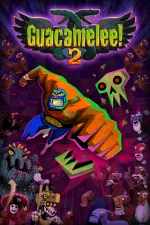Please support Game Informer. Print magazine subscriptions are less than $2 per issue

Guacamelee 2 Review
The first Guacamelee didn’t demand a sequel. It told a succinct and satisfying story, and fully explored its mechanics while nailing the Metroid style of exploration. Guacamelee 2 doesn’t radically change the gameplay established by the first game, but with myriad combat and platforming improvements, a worthwhile story, and better challenges, this is the follow-up I didn’t know I wanted.
Guacamelee 2 picks up seven years after the events of the original game’s good ending. Juan is a family man now, raising his children with his wife who is working on her dissertation. Though his life is different, the gameplay remains familiar; the excellent formula established in the previous entry carries forward and remains strong. Juan is thrust back into the hero role, exploring a connected world, fighting enemies, and finding new abilities that unlock new routes. The areas are designed well and overall do a great job leading you down a path to discover something and then giving you a shortcut back to the starting line toward your next destination. It means you rarely get lost or have to backtrack through the labyrinth and you get to see exciting new areas and challenges at a steady clip.
Juan also earns the ability early on to swap dimensions at will and jump between the world of the living and the dead. The level layout does not change when you swap, but platforms may disappear, and areas that were previously safe may suddenly become lethal. This leads to some of the most engaging challenges as you swap between dimensions to avoid danger while doing high-speed platforming and defeating enemies. The mechanic appeared in the first game, and it’s still clever as hell – though it hasn’t been changed or improved for the sequel.
Both the combat and platforming boast incredibly precise controls. Building up big combos against enemies is fun and gets easier as you level up your special attacks, which happen to double as navigation tools. The uppercut functions as a double jump, and plays into a clever mechanic where breaking through the shields of certain enemies requires specific attacks. A glowing blue enemy requires Juan’s sideways thrust ability which also breaks blue doors, and gives the extra distance often needed to hit a just out-of-reach ledge. This shield-breaking system means you are constantly using Juan’s entire arsenal of moves, preventing you from relying on a favorite attack and approaching fights a little bit like a puzzle. It made every battle consistently exciting.
Along with dimension swapping and all of his combat and navigation abilities, Juan can also turn into a chicken to enter small tunnels. The chicken can do nearly everything Juan can, including fight. In the first game, the chicken felt like a significantly weaker version of Juan that was required for certain platforming sequences, but here the chicken form feels like an extension of Juan with its own additional distinct abilities like being to dash upward through the air multiple times and dash over spike pits with ease.
The world is littered with isolated platforming challenges that test Juan’s limits and the player’s abilities, but you don’t need to complete all of them to see the end credits. One has you climbing high into the sky frequently swapping back and forth between chicken and human, while another places you on a dead sprint to avoid the dimension where the world is full of lava. I eagerly embraced these gauntlets whenever I came across them because they offer big rewards and they are quick and easy to retry when you fail.
Local co-op now supports four players instead of two. Having the option to play with up to four people (who can drop in and out as they please) is awesome, but I had the most fun exploring Guacamelee 2 as a single-player game. The combat works well with multiple players, but the platforming trials, especially the later ones that test your ability to swap between dimensions and chicken and human form on the fly, are made harder by the distraction of having multiple players on screen.
Guacamelee 2 is not afraid to put its influences on display at every opportunity. Allusions to other games as well as assorted pop-culture references litter the various billboards across the world, but you also find more direct references. An early joke paints the world to look like Playdead’s Limbo, while another has you beating up a car just like Street Fighter II’s bonus stage. These references are off the beaten path and serve as fun (and typically optional) rewards for exploring every inch of the world, and I was always eager to uncover them.
As you might guess from the abundant references, the narrative never takes itself too seriously. However, amid the jokes, the sincerity surrounding the relationships Juan has with his friends and family are treated with a great deal of respect. Seeing different versions of characters in different timelines is interesting and both of the endings are satisfying in surprisingly sweet ways. If you plan on seeing the best ending, I highly recommending beating it once before hitting 100% in order to see both ways the story concludes. It’s worth it.
Guacamelee 2 is one of the best executions of the Metroid formula. Juan’s adventure stands apart in a crowded genre, even if it stands apart in the same ways as his last outing. Combat is always exciting, the upgrades change the way you fight and navigate the world in meaningful ways, the world is well-designed, and the optional challenges are substantial and rewarding.
























